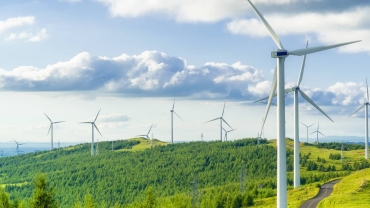
Episode 1: Setting the Stage for Change
Subscribe to our podcast
Sustainable supply chains are efficient, resilient, equitable, circular, transparent and climate positive. In this first episode PwC’s Jeremy Prepscius speaks with Sammie Ho Dumas, Social Impact and Sustainability Director at Williams Sonoma, and Jason Judd, Executive Director at Cornell University, as they explore how supply chains are evolving, the impacts, opportunities and lessons for the future.
Release date: December 2022
Full transcript
Ivy Kuo: Hello, I'm Ivy Kuo, Asia Pacific ESG leader at PwC. And you're listening to PwC Podcast: ESG in Asia Pacific. The podcast for bite size updates on the latest ESG trend. From climate change, to social and labour rights due diligence. The aim is to bring together ESG practitioners to discuss and solve today and tomorrow’s sustainability challenges, which will reflect PwCs The New Equation strategy of building trust and making a lasting difference.
This first series is all about sustainable supply chain, and I'm delighted to introduce you to PwC’s Asia Pacific subject matter expert Jeremy Prepscius.
Jeremy Prepscius: Thanks Ivy, for the introduction. In this podcast series, we will be exploring the issues and changes driving the field of supply chain sustainability. This field is vast and there are many important parts of it, but we'll be focusing on a few key areas, particularly human rights, modern slavery, decarbonization, and the governance aspects, which will impact accountability. We have a great lineup of speakers, including a broad set of professionals from those in the trenches of implementation to the top of corporate leadership. Let's get started with Episode One: Setting the Stage for Shange.
Welcome to this first episode on sustainable supply chains. We're going to be using our discussion to talk about the broad drivers for change in supply chain sustainability. And as we get started, just a short reminder, all opinions are our own and not reflective of any organisation with which we may otherwise be associated. I'm particularly pleased to have, on this discussion, these two guest speakers today, because they have the ability to look backwards in order to help us look forwards. My first guest on this podcast is Sammie Ho Dumas, who is the social impact and sustainability director for William Sonoma and based in Singapore. Sammie, welcome.
Sammie Ho Dumas: Hi, thank you for having me.
Jeremy Prepscius: I think we first met back in various social compliance meetings, in Hong Kong, in the early 2000s, when you were just starting your career as a social compliance auditor.
Sammie Ho Dumas: So I've started my career like Jeremy said, almost 20 years ago as a labour compliance auditor. And in the last 10 years, I really focused my effort on designing capability building programmes to create positive social impact.
Jeremy Prepscius: So my second guest on this podcast is Jason Judd, who is the executive director at Cornell's ILR school, the school of industrial and labour relations. Jason, before going to Cornell, you wore a few different hats. One of which you were wearing back in the early 2000s, when we first met, which was in regards to your Cambodia job. What was that job? And what are some of the experiences that you've gained since?
Jason Judd: Yeah, that's right. 20 years ago. It's been a while. Those were rough and tumble days in our world. I was there, you were there, as part of an experiment to connect trade and labour practices. It was a frontier of sorts. There was huge growth in the apparel industry. And now Cambodia is into electronics and bikes, and there was a place for workers, Cambodian workers, and their organisations. And that was new, not just in Cambodia, but in the neighbourhood. And some of that, what we saw 20 years ago, those connections between trade, or sourcing, and human rights. Now it's showing up in trade policy in the US, the European Union, in these new due diligence rules. Maybe we'll get to talk about all of that.
After Cambodia, I did two stints in the US, in the American labour movement and then two stints in Southeast Asia with the ILO. One, in apparel working for Betterworks. And then more recently fighting forced labour in the seafood industry in fishing. And now here I am, I'm at Cornell University in New York and I help run a research centre focused on what's changing in work and in global production. And what the evidence shows works to improve working conditions. That's me.
Jeremy Prepscius: So people and experiences, evidence of working conditions, what actually works? We're going to get into that in just a minute or two, but let me just round out a bit of these introductions myself. I bring three bits and pieces into this. First of all, those first connections with Sammie and with Jason go back to an accidental and happenstance opportunity that I had to work in Nike's labour practices department, back in the late 1990s, when I was sitting in Ho Chi Minh and Guangzhou working on the labour rights and working conditions.
And after a decade there, I spent 15 years in sustainability consulting here in Asia, and now at PwC in Hong Kong, working on sustainable supply chains. And so I guess between the three of us, we've seen significant change in the industry. We've seen lots of impact and change and what that means on the ground, in the field for workers and for value chains. So let's get started a bit, let's use this opportunity, just folks who are listening in, who probably know this already, but let's just level set and define a few terms. So Sammie, what is a supply chain and why do we have them?
Sammie Ho Dumas: So the supply chain is just about companies trying to look for the best supplier around the world that can produce a product at a certain price, at the right quality and can ship on time. But then in recent years, there is also innovation around the supply chain. We call it the reverse supply chain, because many companies are piloting the circular economy concept. For example, denim is a good one. Company tried to take back post-consumer use denim and then donate it and recycle it for insulating construction materials.
Jeremy Prepscius: I think that's really important. And as we think about supply chains, we look upstream. Who are you buying from? We also need to look downstream, who are you selling to and how does that turn into a circular economy? So that's the supply chain in the broadest sense. Jason, if you could add the other parts here, when we say sustainable supply chains, what do we mean?
Jason Judd: Good question. Well, we're arguing about what sustainability means for supply chains. It's become an impossibly flexible term, but I'd say in short for industry, for investors, its voluntary efforts to improve environment, social and governance ES and G practices from the top down. And for companies that take it seriously, it's an attempt to square the circle, how do global buyers and their investors and manufacturers maintain, or grow their markets and grow their margins, or in some cases just stay in business. And at the same time, try to reduce their environmental impact and improve working conditions. So concretely it could be higher recycled fabric content in a dress, or it could lower greenhouse gas emissions, or of course both. And for business, making sure that the right people see what you're doing, investors, customers, regulators, but there's another end. Sustainability has another side, and seeing from that side from the bottom, seeing from the bottom up, sustainability can look really different and your expectations for it can be totally different. It could be a campaign for a living wage, or it could be dealing with extreme heat where you work, or a flooded home.
Jeremy Prepscius: So it's that tension. How do we avoid the negative externalities? And I think we know a lot about those, but what can we actually build to that's positive? And so when I think about what is the sustainable supply chain, Jason, building on both what you and Sammie have said. I think that the end vision is relatively clear at this point. It's a supply chain that is efficient, it's resilient, it's equitable, meaning it's fair for all the participants within it, including workforces and factories and suppliers. It's transparent, it's circular. And in the end it's going to have to be climate positive. But when I look at the newspaper, if I look at the world almost any day, you can pick it up and see that there are issues. Jason, you've done work on forced labour and Sammie you've been doing work on worker engagement, we still have problems. There's no question about that. What are the challenges? Why haven't we succeeded to the degree we think we should have? Sammie, what do you think?
Sammie Ho Dumas: I think as an industry, the real challenge is really integrating our work into business and to create share value. I think that is very hard, but I'm also optimistic. I also think many brands in the past approach, social and environmental impact at two separate forces, but actually these two are very much intertwined. So I think climate change is that you both talk about is a very good example. How do we not only approach this as reducing emission, but also build capability for workers to prepare for the future, the skillset need maybe change. So how do we prepare for the people side of things as well? And I think the industry will leapfrog in leveraging technology and bring radical transparency and traceability to the supply chain. I think the legislative landscape has changed dramatically in the last few years. Feel like with forced labour, with climate change and Scope 3 emissions, we really need to do a better job in really mapping our supply chain. So I feel like there are a lot of effort and innovation going there, which is very exciting.
Jeremy Prepscius: There's effort in innovation, and there're some changes, lots of big pushes coming on. We'll get to those additionally in a second, to full degree. But Jason, from your side, from sitting at Cornell and looking back at all this work, what have the challenges been? What hasn't worked?
Jason Judd: So this is one of the questions that we've been at work on what went wrong. And we were able to get data from buyers in home goods, in apparel, in food, and compare them across time, across country, across sectors. And with the audit data integrated with the data from the brands showed us, is that over this last decade where you would expect to see the number of labour violations, we were tracking violations of workplace standards. You would expect to see those declining over time. But we didn't see that, the data showed us that across all these sectors, across all these countries, the needle wasn't moving for workers. And we had to try to figure out why that was the case. We looked to it at same factory results. We thought, well, that's just the aggregate picture. That's lots of factories coming in and out of the data, let's look at the same factories over time.
And we took a subset of Indian factories. These were apparel suppliers, and we saw the same problem, that on measures like hours, which you would expect to see decline over time and real wages, which you would expect to see increase over time, there was little, or no improvement. And what that told us was something that we had suspected, those of us who've been in the field all these years, that this cycle of audit, and remediate, and a new PO, and repeat, wasn't driving improvements in working conditions, so that was the diagnosis. And then we had to turn our analytic ray gun on what might be causing that. You want that next. Do you want to know what caused it?
Jeremy Prepscius: Yeah, don't keep us in suspense and what is causing that.
Jason Judd: Well, there's a lot as it's over determined as they say, but one of the big causes, one of the big drivers of this is companies, buyers, for example, often have tonnes, and tonnes, and tonnes, piles of data that they just don't organise and analyse. In part, because they don't employ data scientists to work at this end of the company.
So as a result, too little analysis means sustainability, or human rights teams are still relying on guesswork, which is unacceptable after 25 years. And another big reason is there's lots of bad data, low quality audits. In describing these problems and describing the findings, we're really talking about the whole world of production. So there are of course companies that are assiduous, that are intentional, that build strong, long term relationships with suppliers. They regard them as partners and things get better over time. But on the whole, in the aggregate across these sectors, across these countries, not getting better. And two more reasons. One is, just symbolic compliance. A lot of buyers and their manufacturers are looking the other way, or going through the motions, but not engaging and not trying to improve things at the factory level.
And then the last one, and this is something Sammie was talking about. This needs to effectively integrate sustainability, or human rights teams with sourcing, because sourcing is where the muscle is. That's the business end of the business. And oftentimes, human rights and sustainability teams don't have a way in, they don't figure in the key decisions. And as a result, the worst factories tend to get weeded out there. They're relatively easy to see and the best factories stay in. They become valued partners, but in the vast middle, there are factories that are weak on labour issues, on environmental compliance and they keep getting more orders.
Jeremy Prepscius: I'm going to try to synthesise a bit and then we're going to point towards the future. So one Sammie, as you said, it's a time of change. Two, there's lots of work, not all of it is effective, not all of it is efficient, and much of it doesn't drive any real change. Three, data transparency, intentionality, and relationships actually do matter and do work. And four, if we look to the future, as we look at climate change, the impacts of climate change, the necessity of decarbonizing supply chains, of ensuring that workers and communities are treated fairly in that process, that necessity's going to continue to drive the evolution of this field. Let's go to the next question. What is going to drive us towards change? What is going on in this field that causes you, Sammie, to say we're in a time of change? What's going to change us from 20 years ago to 20 years in the future?
Sammie Ho Dumas: So I think definitely, we need to analyse the data better. But the tricky thing is actually when we look at how far we can influence, I would say that in general, about 20% of our supplier, we do significant enough business so that we can ask them to change. Sometimes it's not like we don't look at the data, it's just like we ask them to do, they don't care. There are a lot of products, particularly more seasonal. Sometimes we buy once a year. So they know that even meeting bare minimum is good enough because we don't have a lot of supply to choose from. If they lose one customer, there will always be another one. I think this is something that, for me, it's a million dollar question, how to change that. But on the other hand, with the 20% that we do have a great relationship, I think this is a great opportunity.
Many of the people in the industry already know that as a business, we really need to have stable and long-term relationship with our supplier, because that is the only incentive to invest in long-term continuous improvement. So I think going forward, definitely thinking about how to continue to identify like-minded business owners, who are willing to run business in a way that are really mindful of its impact.
And on the other hand, I think apart from the top management, another area that we observe is really middle management. So even when we talk about business, we place whatever million out of the business order in a factory, we talk to the business owner, but that middle management does not necessarily agree, because we are asking them to manage how they work, manage the worker differently. So I feel like modernising middle management in developing countries about supervisory skills, about people management skills, is also important, because at the end of day is labour intensive, is a good criteria to be successful, is highly related to how people are being managed.
Jeremy Prepscius: So there's two things I'm going to pull out, Sammie, which I fully agree with. And one is, there is clarity now. I think for most large corporates that intentionality and building relationships with key suppliers is fundamentally important. And that also will lead to investments and efficiency in management skills. And those things will create competitive advantage and value. Fully agree with that. Jason, let's look at it from an industry, or even broader perspective. Those are the actions of individual firms. What's going to influence the environment in which those firms are operating, or the environment in which buyers are operating, that's going to change the incentive and the imperative to go from working with a small set of suppliers, to ensuring that the broader value chain is engaged on social, environment and governance issues.
Jason Judd: I think one of the big drivers is, who's writing the rules and over the last 25 years in the US, for example, in the European union, buyers were largely left to their own devices. There's a whole swath of buyers and their partners, their manufacturers, their contract manufacturers who were untouched by this world of private voluntary regulation. And it's now the threat of public regulation, rules written by somebody else, accountability to another institution in this case government that is, I think, driving change over the next, well, over the next generation. And those look a little different, but I think we could probably describe the main planks. One is, the European style due diligence rules, which will require companies to show that they've built a programme, that they're paying attention to what's happening along their supply chains, all the way to the end. That's new.
And I think we'll just have to wait and see what those European courts, one at a time, decide. And importantly, what liability looks like, will there be some joint liability between a buyer and its manufacturer when things go wrong at the production end. And then there are changes in trade rules and trade agreements. In the past, we've seen a softly, softly approach from the European Union, for example. "Let's ratify ILO conventions. Let's work this into national law," and then there's the hammer.
There is the ban, the force labour ban, now available to policy makers in the US and likely a forced labour ban in the European union. And that'll, I think, drive change in the C-suite. They'll have to think hard about what their new liability is, and they're going to have to go to the end of the supply chain and figure out not just where their stuff is coming, not just trace and disclose, but figure out under what conditions it's made and then figure out how they're going to make change and promptly, and how they're going to be able to show that they've made change, or change in the sourcing strategy, different suppliers, different sourcing countries. I think all that is coming in the next 5, 10 years.
Jeremy Prepscius: We can see this as we sit in Hong Kong and we look at supply chains in the movement of supply chains, somewhat out of China due to a whole variety of issues. Sammie, as supply chains begin shifting, as you look at supply chains in increasing numbers of countries with suppliers operating all over the world again, and a movement of supply chains outside of China, how is that going to affect the balance? What does that mean for how companies need to pick and work with their suppliers?
Sammie Ho Dumas: Resourcing is a question that has been working on in the last few years, not just because of forced labour, because of the tariff situation. I feel like a challenge that the sourcing team right now facing is if we move out China, because China has a full supply chain from raw material to tier one, tier two, tier three all there. So move out China, I think, it will take time for our tier one supplier to reestablish and invest in relationship with the upstream supplier, which will maybe take at least two, three years. So I think three years down the road, the global supply chain will look very different. And at the same time, I really like what Jason is going to and talk about all the new regulation. I think it's actually good for a company that have been doing for a long time, because it will provide a level playing field.
And because sometimes we do source from the factory saying that, "Oh, you're the only customer asking for this and that." So at the end of the day, they look at, "Oh, this is much a premium that I have to do, because you source from me." So it's a regular conversation when we have price negotiation, they will talk about, "Actually, if I don't do X, Y, Z, because of your CSR team, I could probably do this." So I feel like CSR is gradually really becoming part of the cost construction. And that part will continue to grow, because it has to come from somewhere. So I feel like a level playing field will definitely help to motivate supplier as well, because if everyone asks, there is no way for them to find a customer that does not ask them to do any sustainability effort.
Jeremy Prepscius: So the level playing field is, I think really important. And that's where the legislative agenda hopefully will end up. Jason, let me ask an interesting question here. If we see supply chains moving into increasingly many and varied locations and, almost all of them, by definition, will have smaller labour markets than if it existed in China. It means that each supplier's experience will be increasingly unique and managing of environment, and social, and governance challenges within those will also be increasingly varied. How is that going to affect the dynamic between a buyer and a supplier, if buyers fundamentally do need to ensure some basic conformance on environmental, social and governance issues and supply yours and supply chains are increasingly far flung?
Jason Judd: Yeah, it's a good question. I think this question of liability and what's written into the legislation that's coming will drive a lot of this. And I think brands, retailers, buyers of all stripes will get closer, ever closer to their partners. Following Sammie's 80/20, 80% of the products are going to come from 20% of our partners. Those relationships are going to deepen. In fact, we've seen them deep in the COVID era. I think the companies that have spent 25 years building programmes, deepening relationships, improving working conditions at the factory level, they're going to have plenty to be anxious about as these new rules are written, but they're going to have a solid base. It's the rest of the industry. That's running a great risk and I expect to see a big shake out there.
Jeremy Prepscius: So if I take the lessons from this, if I was sitting in a large corporate supply chain, thinking about, okay, this ESG thing, how is it going to affect my future, my sourcing, I hear three things. One is, a regulatory environment is changing and it's coming down the road and liability will probably be in the future. It is actually here already now. So get ready. Number two, is going to be the strategic relationships that I have with my key suppliers, particularly as they move around the world are going to be really important, because that is going to be what mitigates my risks and also allows me to invest for the future, because we're talking about things that are not just labour, but these are about environmental issues. This is about greenhouse gas emissions. This is about the ability to innovate and create new products to go back to what Sammie talked about at the start.
How do we put all of those pieces in a world of a changing regulatory environment that is going to have increasing costs and probably penalties associated with that? Look, as supply chains evolve over the next decade, how they integrate those factors are going to directly affect the world we inhabit. From the impacts of climate change, to the opportunities for inclusion and good jobs, for, as Sammie said, how we value nature and biodiversity. And from that create a product that should be circular, that allows for use and reuse. These impacts will create the world we live in and hopefully will create the world we want.
The next podcast, we will be exploring the aspects of modern slavery and human rights with a new set of discussions. We're going to dive deeper into this topic. And then after that, we'll be exploring some of the other factors, particularly climate and Scope 3 emissions. Please join me as we continue to explore the changing imperatives driving sustainable supply chain. Thank you very much.
Contact us


Asia Pacific Sustainability, Sustainable Supply Chains, Managing Director, PwC Hong Kong
















